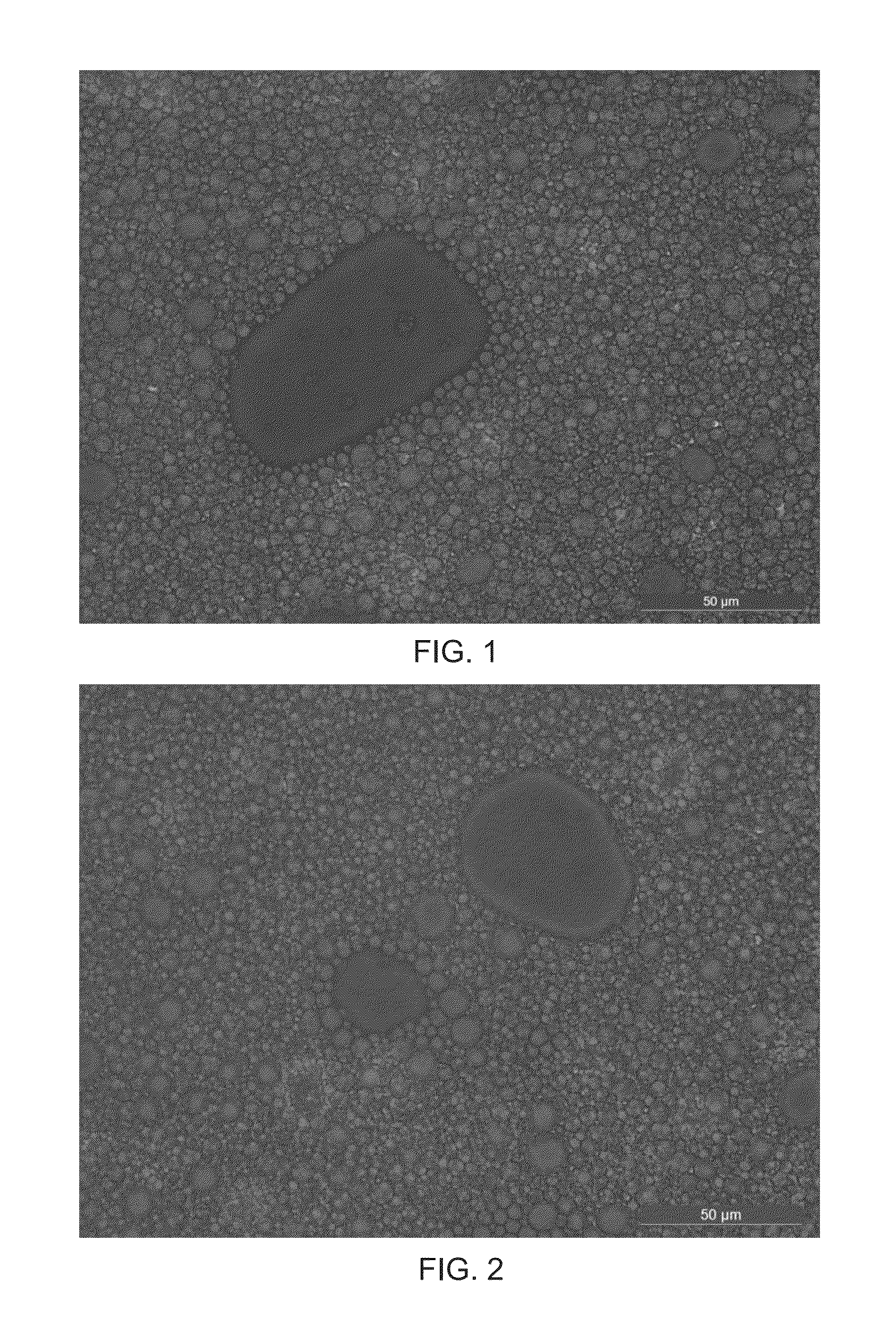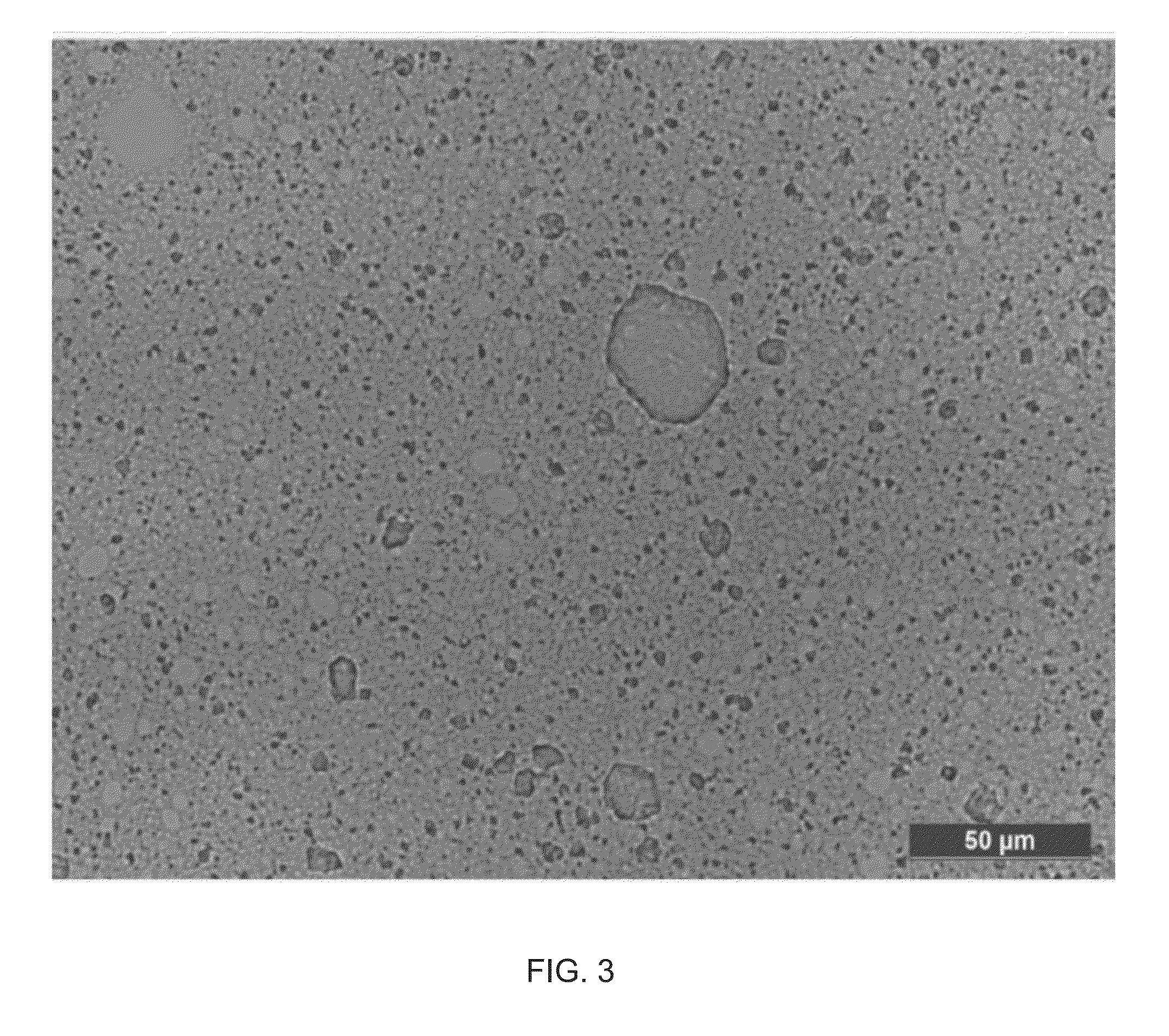Water-releasing cosmetic composition
- Summary
- Abstract
- Description
- Claims
- Application Information
AI Technical Summary
Benefits of technology
Problems solved by technology
Method used
Image
Examples
example 1
[0071]The water-in-oil emulsion of inventive Example 1 is prepared according to the procedure outlined above and includes adding a pH adjuster, citric acid, to the aqueous phase prior to mixing Phase B (aqueous phase) with Phase A (oil phase). Example 1 includes 15% glycerin. The emulsion formed in Example 1 is a white, trembling gel-like cream that releases droplets upon rubbing. The water / silicone emulsion boundary layer is stable and includes droplets having various droplet sizes, with some droplets as large as 50 microns or greater (see FIGS. 1 and 2). The viscosity of Example 1 is measured using a Brookfield Viscometer, using spindle T-D and speed set at 10 rpm. The viscosity of Example 1 is about 74,000 cp (mPa·s). The tackiness of Example 1 is measured using a TA.XT Plus Texture Analyzer. The tackiness of Example 1 is 7.81 Newtons, which indicates little or no tackiness feeling when applied to the skin. The water-releasing effect of Example 1 is measured by placing about 0.2 ...
example 2
[0072]The water-in-oil emulsion of inventive Example 2 is prepared according to the procedure outlined above. Example 2 includes 45% glycerin. The emulsion formed in Example 2 is translucent, white gel-like cream that releases droplets upon rubbing. The water / silicone emulsion boundary layer is stable with smaller and more uniform water droplets. The viscosity of Example 2 is measured using a Brookfield Viscometer, using spindle T-D and speed set at 10 rpm. The viscosity of Example 2 is 63,000 cp (mPa·s). The tackiness of Example 2 is measured using a TA.XT Plus Texture Analyzer as described above. The tackiness of Example 2 is 10.19 Newtons, which indicates there is little or no tackiness feeling when applied to the skin. The water-releasing effect of Example 2 is measured by placing about 0.2 g of the cosmetic composition on the back of a hand. The cosmetic composition is then applied thereon by circling gently with the middle finger and ring finger of the other hand. The phenomen...
example 3
[0073]The water-in-oil emulsion of Example 3 is a comparative example and is prepared according to the procedure outlined above. Example 3 does not include glycerin. The emulsion formed in Example 3 is a frosty-looking, white cream that releases droplets upon rubbing. The water / silicone emulsion boundary layer is stable with various droplet sizes. The viscosity of Example 3 is measured using a Brookfield Viscometer, using spindle T-D and speed set at 10 rpm. The viscosity of Example 3 is 60,000 cp (mPa·s). The tackiness of Example 3 is measured using a TA.XT Plus Texture Analyzer. The tackiness of Example 3 is 8.99 Newtons. Example 3 has little or no tackiness feeling when applied to the skin. The water-releasing effect of Example 3 is measured by placing about 0.2 g of the cosmetic composition on the back of a hand. The cosmetic composition is then applied thereon by circling gently with the middle finger and ring finger of the other hand. The phenomenon of the water-releasing effe...
PUM
| Property | Measurement | Unit |
|---|---|---|
| Fraction | aaaaa | aaaaa |
| Fraction | aaaaa | aaaaa |
| Fraction | aaaaa | aaaaa |
Abstract
Description
Claims
Application Information
 Login to view more
Login to view more - R&D Engineer
- R&D Manager
- IP Professional
- Industry Leading Data Capabilities
- Powerful AI technology
- Patent DNA Extraction
Browse by: Latest US Patents, China's latest patents, Technical Efficacy Thesaurus, Application Domain, Technology Topic.
© 2024 PatSnap. All rights reserved.Legal|Privacy policy|Modern Slavery Act Transparency Statement|Sitemap



